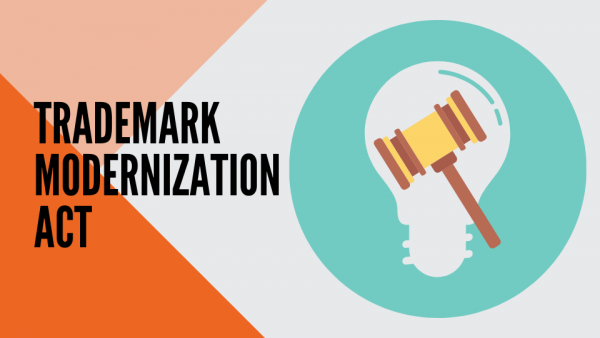
On December 27, 2020, the Trademark Modernization Act (“TMA”) was signed into law, making changes—some effective immediately—to the Lanham Act. Among the changes, some specifically important ones to note are:
- New and more expeditious procedures for ex parte expungement and reexamination of deadwood marks from the federal register;
- Changes to office action response periods;
- Formalization of Letter of Protest procedures; and
- The welcome return of a presumption of irreparable harm for injunctive relief in trademark infringement cases.
Expungement and Reexamination Proceedings
In perhaps the most significant change to trademark law in a long time, the TMA introduces two new ex parte procedures in an effort to modernize the removal process for deadwood trademark registrations. Once effective, these two new mechanisms streamline the process to remove registrations from the register where the trademark has never been used in commerce or was not in use as of the date claimed in the application. Here is how they will work:
- An ex parte expungement proceeding will allow any third-party to challenge registration on the ground that the mark has never been used in commerce with some or all the goods or services listed in the registration. For expungement proceedings based on foreign registrations, the registrant may be allowed to show that non-use is due to special circumstances and is thus excusable.
- An ex parte reexamination proceeding challenges any registration on the ground that the mark was not used in commerce with some or all the goods or services listed in the description on or before the filing date of the application or the filing date of a Statement of Use. Reexamination proceedings are not available in connection with foreign registrations.
Ex Parte Process
When filing a petition for expungement or reexamination, the filing party must present facts that show a reasonable investigation of the registrant’s use of the mark was performed prior to filing. The burden then shifts to the registrant to submit contrary evidence showing the use of its mark or excusable non-use (for marks registered under Section 44(e) or Section 66 of the Lanham Act.) If the Director concludes that the petitioner has established a prima facie case (a decision that is final and non-appealable), the Director will commence an action in which a PTO examiner will decide if the registration should be cancelled in whole or in part. As with office action rejections, the Examiner’s decision is appealable to the Trademark Trial and Appeal Board.
Effect on Businesses
These new procedures should greatly benefit small businesses by providing additional choices for the elimination of dead registrations from the federal register. Once the TMA regulations have been developed—in roughly one year—these procedures will likely offer quicker and less expensive methods for clearing unused marks versus the current sole choice, pursuing cancellation litigation. Hopefully, the threat of expungement or reexamination will encourage trademark applicants and registrants—especially foreign mark owners—to narrow the description of their goods or services to their actual use in commerce.
Other Noteworthy Changes
The TMA also requires the Director of the PTO to implement regulations to establish:
- Shorter office action response periods. Traditionally, the deadline for responding to a PTO Examiner’s application refusal (i.e., an Office Action) is 6-months from the issue date. However, with the passage of the TMA, response time periods may vary depending on the reason for the refusal and could be between 60 days and 6 months. It is hoped this provision will speed up the application examination process.
- Letters of Protest. Effective in 2022, third parties will be able to submit evidence and arguments supporting the refusal of others’ trademark applications—confirming the current Letter of Protest procedure for submission of evidence relevant to the examination of a pending application. Within two months of a third-party submission, the Director will determine whether to include the evidence in the application file for review by the Examiner. This determination is final and non-reviewable.
- Presumption of Irreparable Harm. Last, but certainly not least, the TMA reestablishes a rebuttable presumption of irreparable harm for litigants seeking injunctive relief in trademark infringement cases. This change is important to trademark owners because: (1) it resolves the circuit split and therefore eliminates costs related to forum shopping, (2) it further reduces a trademark plaintiff’s evidentiary burden and costs associated with establishing entitlement to injunctive relief; and (3) perhaps most importantly, it ensures that trademark owners who successfully establish infringement or a likelihood of success on the merits at the preliminary injunction stage have access to meaningful injunctive relief, often the most important relief available to litigants in any trademark case.
Closing Thoughts
In sum, only time will tell how much the Trademark Modernization Act actually helps trademark applicants and owners. The regulations are still in flux. Without precedential decisions to review for guidance, a trademark practitioner’s guidance will be more important than ever to businesses seeking to protect their valuable brands. It’s more important than ever for businesses to closely monitor their trademark usage, to ensure they are using their marks in association with all of the goods or services in which they claim ownership rights. If you don’t, you may find your registration challenged and invalidated.
Navigate the Trademark Modernization Act
Navigate the Trademark Modernization Act with Foundry Law Group trademark lawyers who provide efficient and forward-thinking legal services, mindful of cost without compromising quality. Contact Foundry Law Group to discuss how the Trademark Modernization Act might affect your business.